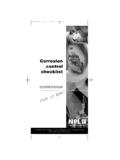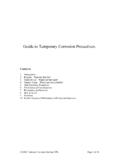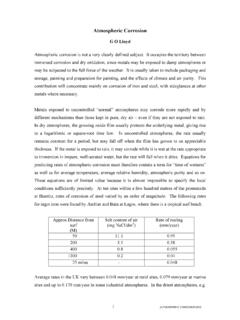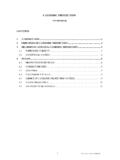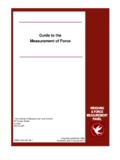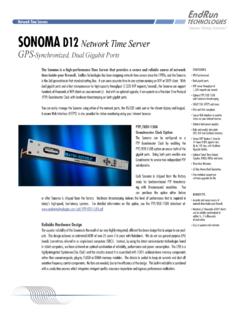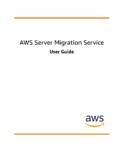Transcription of A USER’S GUIDE TO THE NPL INTERNET TIME SERVICE
1 A USER S GUIDE TO THE NPL INTERNET time SERVICE Contents 's Computer time Services2. The Network time Protocol (NTP)3. Using the NPL INTERNET time Service4. Contacting NPLV ersion 2 Crown Copyright April 2007 Reproduced by permission of the Controller of HMSO National Physical Laboratory | Hampton Road | Teddington | Middlesex | United Kingdom | TW11 0LW Switchboard 020 8977 3222 | 's Computer time ServicesA computer time -stamps every event, such as an e-mail being sent or a file saved, by taking the time from its internal clock. This clock is usually an inexpensive quartz oscillator that can drift by several seconds over a day and gradually build up an error of many minutes. If the computer is to tell the time accurately it must set its internal clock regularly against a trusted external source of time , which must be both accurate and reliable.
2 NPL offers two services that provide access to just such a source - the UK national time scale located at NPL, which is based on a group of atomic clocks. The INTERNET time SERVICE (ITS) allows a computer to set its internal clock byconnecting over the INTERNET to a server at NPL that transmits a time code using thewell-established Network time Protocol (NTP). The NPL ITS provides access to asource of time that is accurate, reliable and traceable. This document explains how toobtain and install software that will allow a computer to use the SERVICE , and providesinstructions for accessing the NPL ITS. The Telephone time SERVICE (TTS) allows a computer to set its internal clock bydirect telephone connection to a server at NPL.
3 A call to the NPL TTS allows acomputer equipped with a suitable modem and software to set its clock to UK localtime and to learn in advance about important time changes. It is particularly valuablein situations where the computer is not connected to the INTERNET , for example in asecurity system where the equipment needs to be tamper-proof, or where a reliablesource of UK local time is required. See the NPL website for more information aboutthis you have any questions about the NPL Computer time Services, or indeed any aspect of time measurement, please get in touch with NPL our contact details are given in Section 4. 2. The Network time Protocol (NTP)The Network time Protocol, or NTP, is the most widely used method for transmitting time information across the INTERNET .
4 NTP version 3 is defined formally in an INTERNET draft standard, RFC 1305 (RFC means Request For Comments), and NTP version 4 is under development. NTP takes as its time reference the international atomic time scale, Coordinated Universal time (UTC), which is kept within seconds of the astronomical time scale Greenwich Mean time by the insertion of leap seconds when necessary. NTP aims to provide the best attainable synchronisation to UTC by using a hierarchy of time servers. At the top are those servers, known as stratum 1, that obtain their time from an external source of UTC National Physical Laboratory | Hampton Road | Teddington | Middlesex | United Kingdom | TW11 0LW Switchboard 020 8977 3222 | as an off-air receiver for GPS or radio time signals.
5 Servers synchronised to one or more stratum 1 servers are known as stratum 2, and so on. A computer can be synchronised using NTP by running client software, which may be a small program running in the background or built into other software such as the operating system. The client sends periodic time requests across the INTERNET or an internal network to one or more (up to five) specified servers. Each call to a server results in an exchange of time -stamped packets of data that allow the client software to estimate the network delay and the rate offset between the client computer s clock and the server, and uses this information to adjust the clock. Repeated calls to a number of servers allow the client software to ignore responses from those that send a time significantly different from the others, and to average the results from those that appear to be correct.
6 Much of the available NTP software makes use of a simplified version of the protocol known as SNTP (Simple Network time Protocol), version 4 of which is defined in the INTERNET draft standard RFC 2030. SNTP client software sets its computer clock by making a single timing request to just one specified server, so it does not perform any averaging and is unable to judge the accuracy of the selected server by comparison with others. The accuracy of synchronisation that can be achieved using NTP varies from better than one millisecond (one thousandth of a second) over an internal company Local Area Network to 30 milliseconds or more for calls to a server located in another continent. The result is highly dependent on the symmetry and speed of the network path between the client and the server.
7 In general, the best performance is obtained using two or three servers that synchronise to different sources, and which are geographically not too distant so that they can be accessed without too many switches between public networks. Further information about the Network time Protocol can be obtained from a wide range of websites. A small selection of the more useful sites is listed below. The 'official home' of NTP at the University of Delaware: official NTP Frequently Asked Questions list: 'Executive Summary' about network time synchronisation: ~ Physical Laboratory | Hampton Road | Teddington | Middlesex | United Kingdom | TW11 0LW Switchboard 020 8977 3222 | Using the NPL INTERNET time ServiceNPL operates two NTP servers that provide INTERNET time SERVICE to users outside NPL.
8 The servers are synchronised using NTP over the NPL local area network to two other servers, which are themselves synchronised to 1 pulse-per-second signals derived from NPL s atomic clocks. The public servers are therefore classed as stratum 2, but they are controlled by a highly reliable source of time the UK national time scale UTC(NPL) - that is traceable directly to UTC and independent of GPS. The NPL INTERNET time Servers can be accessed by specifying their host name or IP address. These addresses are given in the table below. Name Host (DNS) Name IP Address NTP Server 1 NTP Server 2 Any computer with INTERNET access and running a suitable NTP client program should be able to call the NPL ITS servers. NPL does not provide such a program as there is already a wide range of NTP software available from many different sources, including a number of freeware programs that can be downloaded over the INTERNET .
9 However, the following guidance may be of help. If your PC is running Windows XP Home Edition, SNTP capability is already built-in. It can be set up easily by following these on the 'Start' button at the bottom left of the screen and select 'ControlPanel'. you have chosen to use the Classic View, click on "Date and time " andselect the " INTERNET time "tab, or if you are using the Category View, click on"Date, time , Language & Regional Options" then "Change Date and time ",then " INTERNET time ".c. The address of the selected NTP server, such as , can then beentered, and if desired tested using the "Update Now" sure that the "Automatically synchronize with an INTERNET time server"box is on the "OK" button to implement the software will then synchronise the PC clock to the server weekly.
10 NTP capability is also included in Windows 2000 and Windows XP Professional, but it is aimed primarily at synchronising a number of computers within a 'domain' and is more complex to set up. If you would like more detailed instructions, there is a document on the website of the US National Institute of Standards and Technology National Physical Laboratory | Hampton Road | Teddington | Middlesex | United Kingdom | TW11 0LW Switchboard 020 8977 3222 | (NIST) that explains how to set up and use the SNTP facility in various versions of Windows, which can be found at this address: This webpage has a list of links to websites offering free software for use withWindows PCs: The NIST website also maintains a list of web addresses of all companies known topublish NTP software.

